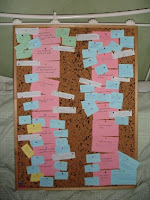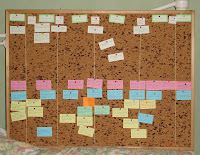Nothing too special. Just a A1-sized cork board with added bits of string, pins and headings on cut-up index cards. However, I've found I'd struggle to write a book without it!
I can’t claim to have invented the idea – far from it – but I’ve been tweaking my own approach for about ten years now. I don't always use the board the same way twice - it really depends on the story, but I'm fascinated about plotting and story structure and I wondered if blogging about my process as I write the next book might a) be useful to someone else who loves this kind of stuff and b) actually help me work out exactly why this helps me so much!
I think part of it is that I’m quite a visual thinker and it helps me to ‘see’ the structure of my book this way. It also provides a place to put all those ‘lightning bolt’ ideas I get about my book before, during and after the first draft. You know the kind of ideas I mean: the ones you get when you’re minding your own business, not even really thinking about the book and – BAM! – suddenly you know why your heroine is acting that way, or the perfect setting for a scene comes to mind, or just a line of dialogue pops into your head and triggers something off.
 When
I get those kind of ideas – and they are generally my best ones – I
scribble them down and pin them to my board. My board follows a
chronological timeline of my work-in-progress, and when I think about
where to pin that scrap of paper it often becomes instantly obvious
where and when it should go. Do things move and change as I work on the
book? Absolutely. That’s why God gave us coloured pins! That’s the
beauty of a plot board: nothing is set in stone.
When
I get those kind of ideas – and they are generally my best ones – I
scribble them down and pin them to my board. My board follows a
chronological timeline of my work-in-progress, and when I think about
where to pin that scrap of paper it often becomes instantly obvious
where and when it should go. Do things move and change as I work on the
book? Absolutely. That’s why God gave us coloured pins! That’s the
beauty of a plot board: nothing is set in stone.My first plot board looked a little different. My whole approach to plotting was much less sophisticated (and probably much less neurosis-inducing) back then. I’d read that a good way to plot was to think of 20 things that needed to happen in your book. That’s what the pink index cards are: 20 plot points for the story. Then, as other ideas came to me, or notions of how I could develop those plot points floated to the surface of my consciousness, I tacked them onto the board next to the relevant plot point.
 I then switched to trying to divide the board into acts. I particularly liked Michael Hauge's way of breaking down a story, I tried dividing my board into six stages with five turning points, on the right, but found I couldn't quite fit everything on there so it was easy to see the flow of the story. Then I read Save The Cat by Blake Snyder. Great book, and I loved his
idea of storyboarding too. He divided his story board into four
horizontal strips: Act 1, Act 2a, Act 2b and Act 3. I immediately
decided to try the same thing, and discovered I now had room to use my
plot point cards in chronological order, but I still had room to pin all
the little flashes of ideas around them too. So this is what the plot board of my recently finished book, The Other Us, looks like:
I then switched to trying to divide the board into acts. I particularly liked Michael Hauge's way of breaking down a story, I tried dividing my board into six stages with five turning points, on the right, but found I couldn't quite fit everything on there so it was easy to see the flow of the story. Then I read Save The Cat by Blake Snyder. Great book, and I loved his
idea of storyboarding too. He divided his story board into four
horizontal strips: Act 1, Act 2a, Act 2b and Act 3. I immediately
decided to try the same thing, and discovered I now had room to use my
plot point cards in chronological order, but I still had room to pin all
the little flashes of ideas around them too. So this is what the plot board of my recently finished book, The Other Us, looks like:So that's the introduction to my plot board, next time... the different stages of a story and where they go on the plot board.


